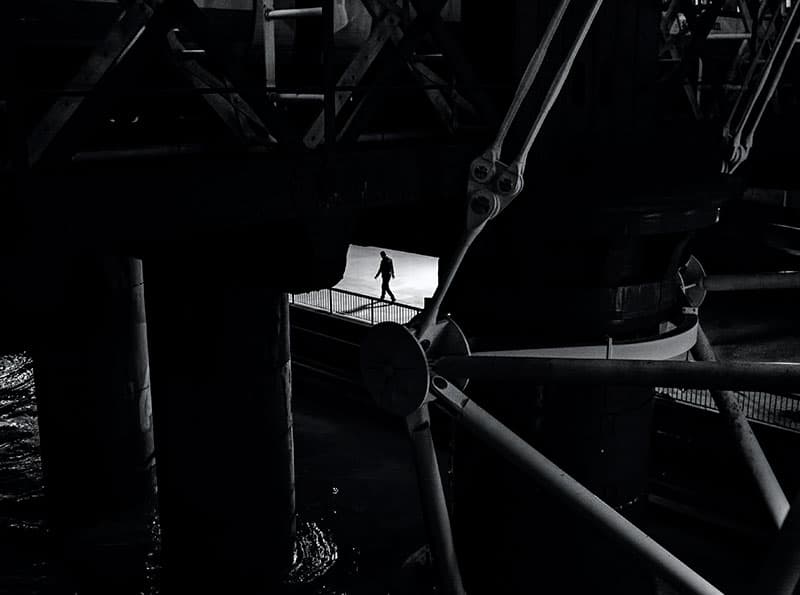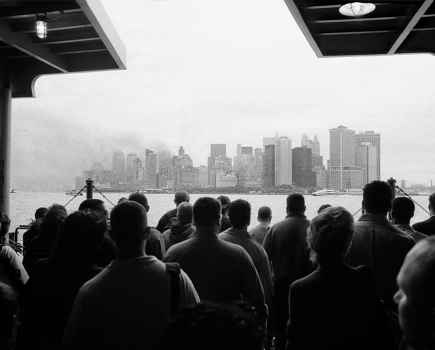Photo Insight with Rupert Vandervell – Man on Earth

London-based Rupert Vandervell has spent most of his life working in video and design and decided to return to photography recently at the age of 50. Working in black & white, he has spent the last year capturing life on the streets of his home city. Photography for him is a way of bringing together both the emotional and creative sides of his character.
Rupert Vandervell explains the themes behind his series Man on Earth and how he set about capturing such atmospheric city scenes
My professional career has been spent largely working in video design. My series Man on Earth was my return to stills photography. I love the idea of capturing a single moment that you can keep returning to and each time feel something different about it. Everyone views a picture differently and we can all put something of ourselves into it to complete the effect.
With Man on Earth, I was keen to highlight the dramatic contrast between the urban environment and the small yet crucial presence of human life, and the unique visual characteristics that go with it. I was looking to portray a feeling of isolation. One of the important ways that I wanted to approach the subject was to remain somewhat distant from the scenes, yet in some ways intrude on these little pockets of solitude – something that occurs naturally through photographing these individuals. With our crowded world and our ever-increasing population numbers, solitary moments like this are becoming harder to find. I was fascinated by the idea of photographing someone who appeared to be the last man on earth.
One of the key things for me was to avoid showing any recognisable landmarks or places. I felt that if there were a level of anonymity to the surroundings then it would give the impression that it could be any city. It was important to keep the surroundings quite featureless and let the light and shade, coupled with the city’s geometric shapes, add the necessary environmental interest.
This project was actually shot in London, which is a city I know very well. Despite my familiarity with the location, I still found myself having to explore to find locations with the right kind of ambience. It was also important to find locations that would work well for night shots, as I wanted a contrast to the bright daylight images. The image you see here is one of those night shots.
I love how light is able to interact with the structures in our cities. Often I’ll stand and watch the changing shapes of the shadows and their impact upon the streets and buildings. Observing the human form against this, and seeing how it moves through it, is a source of deep fascination for me.
A lot of people have placed this project under the umbrella of street photography. That’s an interesting way of looking at it. I guess my approach to the project is really a reflection of my own personality. Showing the city in such a clean and economic way allowed me to highlight the human figure more expressively. I wanted the streets to act like a stage – a set where the human figure would become an actor. Of course, the challenge here is that when using a passer-by as your subject, it can be difficult to capture them in the right way – particularly when they don’t behave in the way you want.

Living in London, we have more than our fair share of grey skies and dull days and I often found myself waiting for the right conditions to work with. Finding the balance between light and shade was really the main challenge with these pictures. With good light you get good shadows, and it is what is potentially hidden in those shadows that I find most intriguing. It heightens the sense of mystery. At night, a good source of illumination in the right place was key and this led to a lot of location hunting. The night images were absolutely essential to the overall theme of this series.
Shooting in black & white was important for this project because its starkness stripped away any positivity and accentuating feelings of isolation. I did try some colour work, but its message was quite different as it tended to confuse the overall effect.
Exposing for these scenes was something I initially experimented with. Eventually, I hit upon a method that worked. I would generally expose for the highlights and then work with the depth of shadow, depending on the scene. At night that was harder because I would often be working with a limited light source. If I wanted to freeze a figure in action I would have to work with a high ISO to get the shutter speed I needed. This obviously introduced noise and that meant there were some scenes I had to lose because they were too grainy.
There was minimal work done in post-production for these shots – just a bit of contrast adjustment and the occasional bit of cropping. There was only so much that I could do in Photoshop to fix and tidy an image. Generally, if I find the right conditions on location, then it is perfectly reasonable to expect I can get it right in-camera.
When I started shooting this project, I knew I needed a camera that was lightweight and easy to conceal. I found the perfect camera in the Olympus OM-D E-M5 with a 20mm pancake lens. Lugging a big SLR around would have made the job a lot harder. The Olympus is fast and I love the design. I always felt it was right for the job.
I think there are common themes in all my work. When shooting landscapes, I am drawn to bleak or minimalist scenes and much prefer to shoot in winter when the trees’ natural geometry is stripped bare. I’m drawn to the geometrical. I hope I put something of my personality into all that I create and I hope there are elements of this project that will be evident in my future work.
Rupert Vandervell was talking to Oliver Atwell








